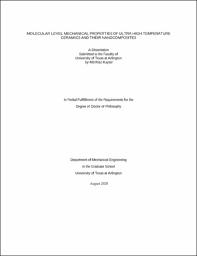
ATTENTION: The works hosted here are being migrated to a new repository that will consolidate resources, improve discoverability, and better show UTA's research impact on the global community. We will update authors as the migration progresses. Please see MavMatrix for more information.
Show simple item record
| dc.contributor.advisor | Adnan, Ashfaq | |
| dc.creator | Kayser, Md Riaz | |
| dc.date.accessioned | 2020-09-10T15:18:55Z | |
| dc.date.available | 2020-09-10T15:18:55Z | |
| dc.date.created | 2020-08 | |
| dc.date.issued | 2020-08-19 | |
| dc.date.submitted | August 2020 | |
| dc.identifier.uri | http://hdl.handle.net/10106/29395 | |
| dc.description.abstract | Ultra High-Temperature Ceramics (UHTC) have been of great interest in the spacecraft, aerospace, and aeronautic industry due to their high melting point and their potential application as a protective material for the stagnation areas of leading edges. In this work, the effect of nanoparticle reinforcement for achieving tailored mechanical properties of UHTC’s has been studied. Two different material systems have been considered, namely the ZrB2-based and the HfO2-based nanocomposites. In the first study, the grain boundary driven mechanical behavior of polycrystalline ZrB2 and ZrC-ZrB2 nanocomposites using large-scale molecular dynamics simulations have been performed. The atomistic models of polycrystalline ZrB2 and ZrC-ZrB2 nanocomposite were subjected to tensile loading to determine their elastic constants and strengths. It has been found that the presence of nanoparticles imparts an insignificant effect on the mechanical properties of ZrB2. It has also been observed that failure mechanisms of both ZrB2 and ZrC-ZrB2 nanocomposite are driven by grain boundary deformation. In the second study, an atomistic computational study of electric field and thermal effects on the mechanical behavior of memristor material HfO2 have been performed. Since the material has non-symmetric crystal structure, it is observed that tensile properties along the x, y and z directions are different. In addition, the effects of electrical field on mechanical behavior are studied by varying the electrical field intensity from 0 to 0.3 v/Å gradually. For each case, atomistic snapshots are taken to identify the changes occur in the structure due to the electric field. A significant structural damage on the crystal structure of HfO2 is observed after applying 0.3 v/Å electric field, whereas the structural change is insignificant when the magnitude of the electric field is 0.2 v/Å or less. To understand more about the damage of this material, shear loads are applied in different directions and their responses are studied in this work. | |
| dc.format.mimetype | application/pdf | |
| dc.language.iso | en_US | |
| dc.subject | Atomistic simulation | |
| dc.subject | Borides | |
| dc.subject | Failure | |
| dc.subject | Grain boundaries | |
| dc.subject | Nanocomposites | |
| dc.subject | Memristor | |
| dc.subject | Hafnium dioxide (HfO2) | |
| dc.subject | Molecular dynamics | |
| dc.subject | Electric field | |
| dc.subject | Mechanical properties | |
| dc.subject | Neuromorphic computation | |
| dc.title | MOLECULAR LEVEL MECHANICAL PROPERTIES OF ULTRA HIGH TEMPERATURE CERAMICS AND THEIR NANOCOMPOSITES | |
| dc.type | Thesis | |
| dc.degree.department | Mechanical and Aerospace Engineering | |
| dc.degree.name | Doctor of Philosophy in Mechanical Engineering | |
| dc.date.updated | 2020-09-10T15:18:56Z | |
| thesis.degree.department | Mechanical and Aerospace Engineering | |
| thesis.degree.grantor | The University of Texas at Arlington | |
| thesis.degree.level | Doctoral | |
| thesis.degree.name | Doctor of Philosophy in Mechanical Engineering | |
| dc.type.material | text | |
Files in this item
- Name:
- KAYSER-DISSERTATION-2020.pdf
- Size:
- 5.727Mb
- Format:
- PDF
This item appears in the following Collection(s)
Show simple item record


